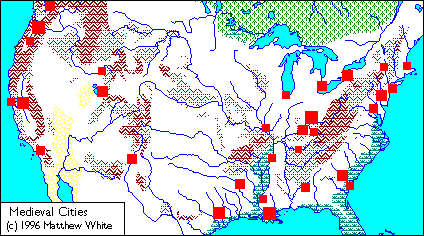
Trade

|
The building blocks of industrial civilization were geologic in origin -- coal, steel, oil and aluminum -- so the most important trade routes usually connected different geologic zones. The building blocks of the Middle Ages, however, are more likely to be biologic -- wood, leather, wool and wine -- so the principle trade routes nowadays connect different biologic zones. They most often run north to south, swapping the sugar, cotton and tobacco of the long sub-tropical growing season for the soft, thick fur and wool of the colder north. Other routes move from the salt pans and ranches of the arid west to the farmlands of the moist east. There is very little trade across the Appalachians because the inhabitants of each side have access to pretty much the same catalog of crops, and there's no big need to shuffle things around. The focal point of the North American trade network is New Orleans, where the continent's primary river pours into an inland sea. Here coffee, cocaine, balsa and rubber from South America is stockpiled in warehouses along side leather from Texas, cotton from Tennessee and SALT: The human need for salt is met in most places by channelling sea water into wide, shallow pond and allowing the water to evaporate, leaving behind a crusty film of salt. In the Midwest, however, they have no convenient sea from which to get their salt water, so it has to be imported from far away. Much of it comes up the Missisippi from the arid coast of Texas where salt dries more quickly than it does along the more humid coast of Louisiana, but an even better source is Utah where ancient lakebeds in the desert are mined for their vast deposits. It is therefore vital to Midwesterners that the road to Utah stay open, and the merchants of St. Louis spend a great deal of money placating the nomadic tribes of Nebraska in order to guarantee safe passage of their caravans. This influx of cash has made the Rizzini tribe among the most affluent and civilized of all the plainsmen.
[Tips] Last Updated July 2003 Copyright © 1999-2003 Matthew White |
